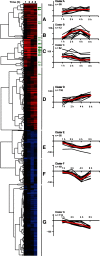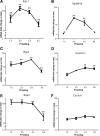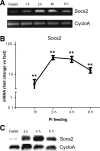Profiling CCK-mediated pancreatic growth: the dynamic genetic program and the role of STATs as potential regulators
- PMID: 22010007
- PMCID: PMC3289124
- DOI: 10.1152/physiolgenomics.00255.2010
Profiling CCK-mediated pancreatic growth: the dynamic genetic program and the role of STATs as potential regulators
Abstract
Feeding mice with protease inhibitor (PI) leads to increased endogenous cholecystokinin (CCK) release and results in pancreatic growth. This adaptive response requires calcineurin (CN)-NFAT and AKT-mTOR pathways, but the genes involved, the dynamics of their expression, and other regulatory pathways remain unknown. Here, we examined the early (1-8 h) transcriptional program that underlies pancreatic growth. We found 314 upregulated and 219 downregulated genes with diverse temporal and functional profiles. Several new identifications include the following: stress response genes Gdf15 and Txnip, metabolic mediators Pitpnc1 and Hmges2, as well as components of growth factor response Fgf21, Atf3, and Egr1. The genes fell into seven self-organizing clusters, each with a distinct pattern of expression; a representative gene within each of the upregulated clusters (Egr1, Gadd45b, Rgs2, and Serpinb1a) was validated by qRT-PCR. Genes up at any point throughout the time course and CN-dependent genes were subjected to further bioinformatics-based networking and promoter analysis, yielding STATs as potential transcriptional regulators. As shown by PCR, qPCR, and Western blots, the active phospho-form of STAT3 and the Jak-STAT feedback inhibitor Socs2 were both increased throughout early pancreatic growth. Moreover, immunohistochemistry showed a CCK-dependent and acinar cell-specific increase in nuclear localization of p-STAT3, with >75% nuclear occupancy in PI-fed mice vs. <0.1% in controls. Thus, the study identified novel genes likely to be important for CCK-driven pancreatic growth, characterized and biologically validated the dynamic pattern of their expression and investigated STAT-Socs signaling as a new player in this trophic response.
Figures







Similar articles
-
Regulator of calcineurin 1 controls growth plasticity of adult pancreas.Gastroenterology. 2010 Aug;139(2):609-19, 619.e1-6. doi: 10.1053/j.gastro.2010.04.050. Epub 2010 Jun 18. Gastroenterology. 2010. PMID: 20438729 Free PMC article.
-
Cholecystokinin activates pancreatic calcineurin-NFAT signaling in vitro and in vivo.Mol Biol Cell. 2008 Jan;19(1):198-206. doi: 10.1091/mbc.e07-05-0430. Epub 2007 Oct 31. Mol Biol Cell. 2008. PMID: 17978097 Free PMC article.
-
Calcineurin mediates pancreatic growth in protease inhibitor-treated mice.Am J Physiol Gastrointest Liver Physiol. 2004 May;286(5):G784-90. doi: 10.1152/ajpgi.00446.2003. Epub 2003 Dec 18. Am J Physiol Gastrointest Liver Physiol. 2004. PMID: 14684381
-
Stimulation of in vivo pancreatic growth in the rat is mediated specifically by way of cholecystokinin-A receptors.Gastroenterology. 1994 Oct;107(4):1135-46. doi: 10.1016/0016-5085(94)90239-9. Gastroenterology. 1994. PMID: 7523219 Review.
-
Cholecystokinin (CCK) Regulation of Pancreatic Acinar Cells: Physiological Actions and Signal Transduction Mechanisms.Compr Physiol. 2019 Mar 14;9(2):535-564. doi: 10.1002/cphy.c180014. Compr Physiol. 2019. PMID: 30873601 Review.
Cited by
-
ERK activation is required for CCK-mediated pancreatic adaptive growth in mice.Am J Physiol Gastrointest Liver Physiol. 2014 Oct 1;307(7):G700-10. doi: 10.1152/ajpgi.00163.2014. Epub 2014 Aug 7. Am J Physiol Gastrointest Liver Physiol. 2014. PMID: 25104499 Free PMC article.
-
Cardiac energy dependence on glucose increases metabolites related to glutathione and activates metabolic genes controlled by mechanistic target of rapamycin.J Am Heart Assoc. 2015 Feb 24;4(2):e001136. doi: 10.1161/JAHA.114.001136. J Am Heart Assoc. 2015. PMID: 25713290 Free PMC article.
-
Non-canonical Wnt signaling pathway activated NFATC3 promotes GDF15 expression in MASH: prospective analyses of UK biobank proteomic data.Hepatol Int. 2025 Jun;19(3):662-672. doi: 10.1007/s12072-024-10775-2. Epub 2025 Jan 21. Hepatol Int. 2025. PMID: 39836348
References
-
- Bragado MJ, Groblewski GE, Williams JA. Regulation of protein synthesis by cholecystokinin in rat pancreatic acini involves PHAS-I and the p70 S6 kinase pathway. Gastroenterology 115: 733–742, 1998. - PubMed
-
- Cartharius K, Frech K, Grote K, Klocke B, Haltmeier M, Klingenhoff A, Frisch M, Bayerlein M, Werner T. MatInspector and beyond: promoter analysis based on transcription factor binding sites. Bioinformatics 21: 2933–2942, 2005. - PubMed
-
- De Leon DD, Farzad C, Crutchlow MF, Brestelli J, Tobias J, Kaestner KH, Stoffers DA. Identification of transcriptional targets during pancreatic growth after partial pancreatectomy and exendin-4 treatment. Physiol Genomics 24: 133–143, 2006. - PubMed
-
- Elsasser H-P, Adler G, Kern HF. Replication and regeneration of the pancreas. In The Pancreas: Biology, Pathobiology, and Disease, edited by Vay Liang W. New York: Raven, 1993 p. 75–86.
Publication types
MeSH terms
Substances
Grants and funding
LinkOut - more resources
Full Text Sources
Other Literature Sources
Molecular Biology Databases
Research Materials
Miscellaneous

